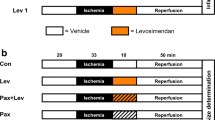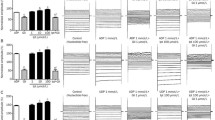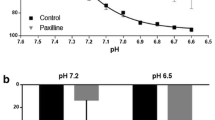Abstract
Levosimendan, a new type of inodilator drugs, is known to activate membrane adenosine 3′,5′-triphosphate-sensitive potassium (KATP) channels in some vascular smooth muscles and causes vasorelaxation. The involvement of potassium channels in the mechanism of the coronary artery relaxing effect of the drug has not been established. In the present study performed in the porcine epicardial coronary artery, the effect of levosimendan (0.009–3.2 μM) was compared to cromakalim (0.0125–5 μM), the known activator of ATP-sensitive potassium (KATP) channels, in the presence of glibenclamide (GLI), an inhibitor of KATP channels and tetraethylammonium (TEA), the non-selective inhibitor of potassium channels. The interaction of levosimendan with the specific calcium-activated potassium channel (KCa) blocker, iberiotoxin (IBTX), and the voltage-sensitive potassium channel (KV) blocker, 4-aminopyridine (4-AP), was also studied. All the experiments were performed in the isometric tension of endothelium denuded porcine isolated epicardial coronary arteries precontracted with 20 mM potassium chloride. 1 μM GLI decreased the maximum of cromakalim-induced relaxation by 60% but did not affect the action of levosimendan. In contrast, 2 mM TEA decreased only the coronary artery relaxing effect of levosimendan. 100 nM IBTX suppressed the maximum effect of levosimendan by only 15% while 0.5 mM 4-AP significantly shifted the concentration-response curve of the inodilator to the right. 5 mM 4-AP caused a maximum of 33% decrease of levosimendan-induced relaxation. These results indicate that, in porcine isolated epicardial coronary artery, the vasorelaxing mechanism of levosimendan involves the activation of voltage-sensitive and, at large concentrations, calcium-activated potassium channels.
Similar content being viewed by others
References
Papp JGy. Introduction: Positive inotropy by calcium sensitization-An evolving approach for the treatment of end-stage heart failure. Am J Cardiol 1999;83(12B):1-3.
Follath F, Cleland JGF, Just H, et al. Efficacy and safety of intravenous levosimendan compared with dobutamine in severe low-output heart failure (the LIDO study): A randomised double-blind trial. Lancet 2002;360:196-202.
Haikala H, Kaivola J, Nissinen E, Wall P, Levijoki J, Lindén I-B. Cardiac troponin C as a target protein for a novel calcium sensitizing drug, levosimendan. J Mol Cell Cardiol 1995;27:1859-1866.
Yokoshiki H, Katsube Y, Sunagawa M, Sperelakis N. The vasodilator levosimendan hyperpolarizes and activates a glibenclamide-sensitive potassium channel in vascular smooth muscle cells. Eur J Pharmacol 1996;333:249-259.
Lilleberg J, Nieminen MS, Akkila J, et al. Effects of a new calcium sensitizer, levosimendan, on haemodynamics, coronary blood flow and myocardial substrate utilization early after coronary artery bypass grafting. Eur Heart J 1998;19:660-668.
Pataricza J, HÓhn J, Petri A, Balogh À, Papp JGy. Comparison of the vasorelaxant effect of cromakalim and the new inodilator, levosimendan, in human isolated portal vein. J Pharm Pharmacol 2000;52:213-217.
Bowman P, Haikala H, Paul RJ. Levosimendan, a calcium sensitizer in cardiac muscle, induces relaxation in coronary smooth muscle through calcium desensitization. J Pharmacol Exp Ther 1999;288:316-325.
Gruhn N, Nielsen-Kudsk JE, Theilgaard S, Bang L, Olesen SP, Aldershvile J. Coronary vasorelaxant effect of levosimendan, a new inodilator with calcium-sensitizing properties. J Cardiovasc Pharmacol 1998;31:741-749.
Kersten JR, Montgomery MW, Pagel PS, Warltier DC. Levosimendan, a new positive inotropic drug, decreases myocardial infarct size via activation of K(ATP) channels. AnesthAnalg 2000;90:5-11.
KÓppel H, Holzmann S, Pilger E, Klein W, Gasser R. Minimal effects of levosimendan on coronary artery smooth muscle tone. Cardiovasc Drugs Ther 1999;13:357-358.
Krassói I, Pataricza J, Papp JGy. Comparison of the effect of cromakalim in porcine and human coronary arteries. Cardiovasc Drugs Ther 1999;13:52 (A197).
Hamilton TC, Weir SW, Weston AH. Comparison of the effects of BRL 34915 and verapamil on electrical and mechanical activity of rat portal vein. Br J Pharmacol 1986;88:103-111
Edwards G, Feletou M, Gardener MJ, et al. Further investigations into the endothelium-dependent hyperpolarizing effects of bradykinin and substance P in porcine coronary artery. Br J Pharmacol 2001;133:1145-1153.
Shimizu S, Yokoshiki H, Sperelakis N, Paul RJ. Role of voltage-dependent and Ca(2+)-activated K(+) channels on the regulation of isometric force in porcine coronary artery. J Vasc Res 2000;37:16-25.
Fujino K, Nakaya S, Wakatsuki T, et al. Effects of nitroglycerin on ATP-induced Ca(++)-mobilization, Ca(++)-activated K channels and contraction of cultured smooth muscle cells of porcine coronary artery. J Pharmacol Exp Ther 1991;256:371-377.
Petkova-Kirova P, Gagov H, Krien U, Duridanova D, Noack T, Schubert R. 4-aminopyridine affects rat arterial smooth muscle BK(Ca) currents by changing intracellular pH. Br J Pharmacol 2000;131:1643-1650.
Inoue I, Nakaya Y, Nakaya S, Mori H. Extracellular Ca 2+-activated K channel in coronary artery smooth muscle cells and its role in vasodilation. FEBS Lett 1989;255:281-284.
Wakatsuki T, Nakaya Y, Inoue I. Vasopressin modulates K+-channel activities of cultured smooth muscle cells from porcine coronary artery. Am J Physiol 1992;63:H491-H496.
Kopustinskiene DM, Pollesello P, Saris NE. Levosimendan is a mitochondrial K (ATP) channel opener. Eur J Pharmacol 2001;428:311-314.
Sandell EP, Hayha M, Antila S, et al. Pharmacokinetics of levosimendan in healthy volunteers and patients with congestive heart failure. J Cardiovasc Pharmacol 1995: 26(Suppl. 1):S57-S62.
Krassói I, Pataricza J, Kun A, Papp JGy. Calcium-dependent vasorelaxant capacity of levosimendan in porcine and human epicardial coronary artery preparations. Cardiovasc Drugs Ther 2000;14:689-691.
Haikala H, Linden I-B. Mechanisms of action of calciumsensitizing drugs. J Cardiovasc Pharmacol 1995;26(Suppl. 1):S10-S19.
Author information
Authors and Affiliations
Rights and permissions
About this article
Cite this article
Pataricza, J., Krassói, I., Höhn, J. et al. Functional Role of Potassium Channels in the Vasodilating Mechanism of Levosimendan in Porcine Isolated Coronary Artery. Cardiovasc Drugs Ther 17, 115–121 (2003). https://doi.org/10.1023/A:1025331617233
Issue Date:
DOI: https://doi.org/10.1023/A:1025331617233




